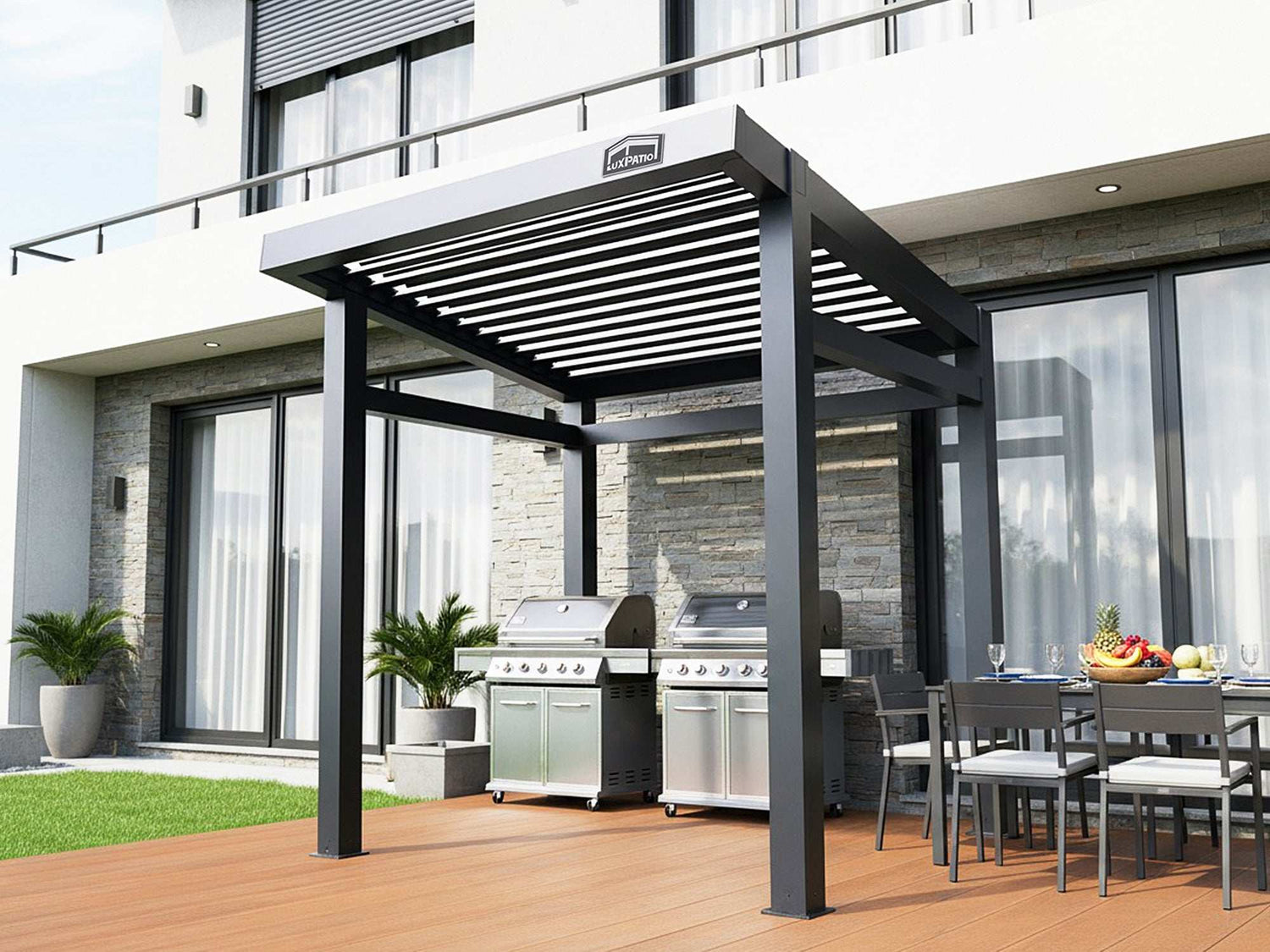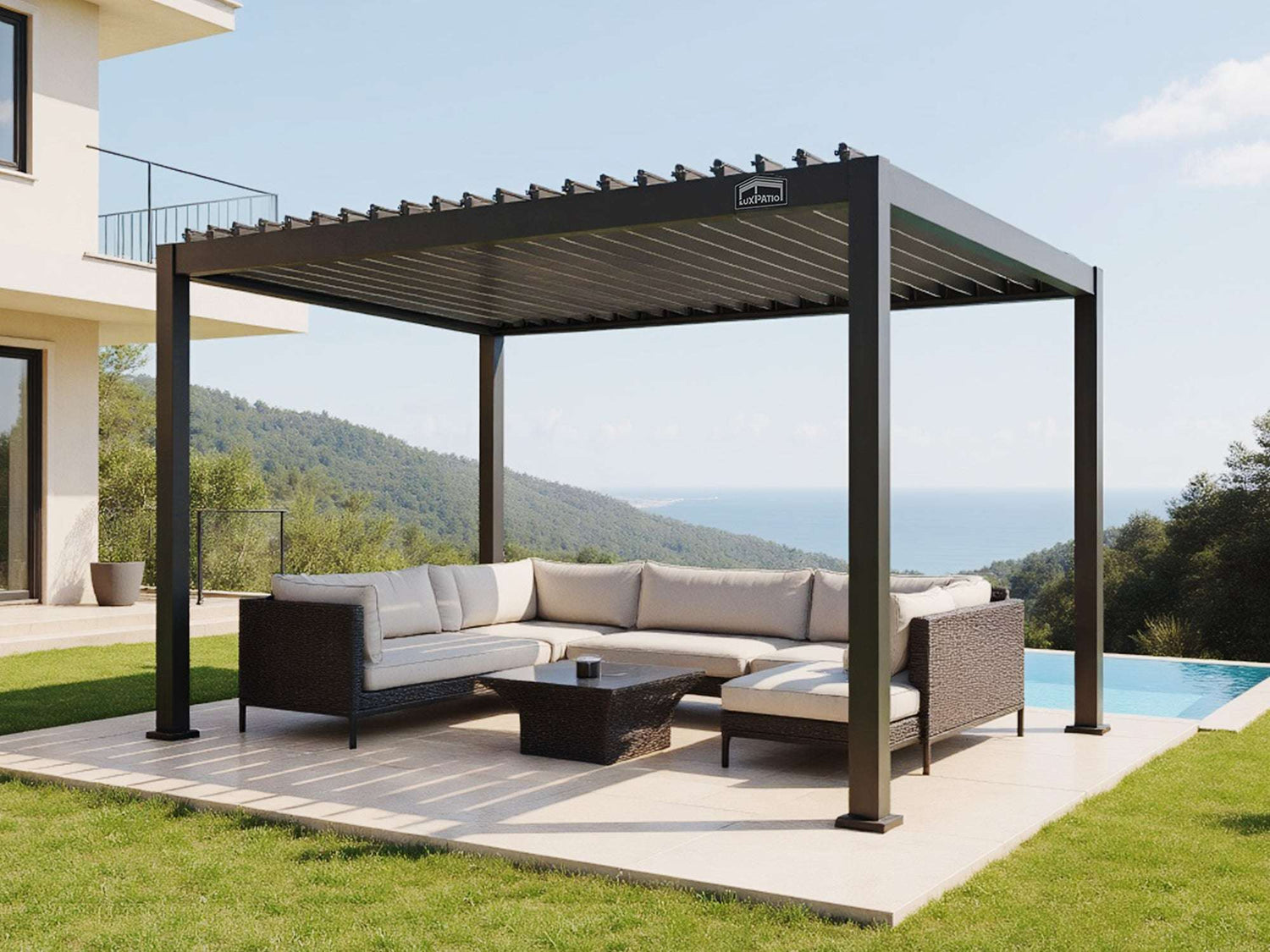Rain has a way of testing every outdoor upgrade. You plan a dinner, the grill smells amazing, friends are finally relaxed, and then the clouds roll in. A louvered pergola looks like the perfect safety net. Close the roof, stay outside, keep the vibe. The real question is simple and a bit scary: will water still find its way through once the storm gets serious?
This article keeps things practical. You will see how these roofs actually handle rain, what they do well, where leaks usually come from, and what that means for your backyard plans and budget.
The Short Answer: They Are Highly Water-Resistant, Not Magically Waterproof
In normal rain, a good system keeps people and furniture comfortably dry. In heavy, wind-driven storms or when drainage is blocked, you can still see a few drips at the edges and corners. Think "excellent rain protection", not "sealed indoor ceiling".

Key Benefits of Louvered Pergolas
Most owners ask about waterproofing because they want to use their patio many more days each year. A louvered pergola helps that happen in several very concrete ways.
Flexible Light and Shade
On bright days, you open the louvers and let the whole sky back into the space. Midday heat kicks in, so you tilt the blades and create deep shade while daylight still reaches the table. In the evening, you can open the roof again for the breeze and the stars. Compared with a fixed pergola with a roof, this fine control over light and shade makes a real difference in how long people actually stay outside.
Real Rain Protection and Comfort
Clouds move in, you close the louvers, and the roof turns into a smooth plane. Rain lands on the surface, slides toward hidden gutters, and exits quietly at the posts. Drinks stay on the table, food does not get soaked, and nobody has to panic and rush inside. You still hear the sound of rain, which feels cozy, yet the floor and chairs remain usable.
Making the Patio Investment Pay Off
Decking, stone, outdoor kitchens, and fire features absorb a lot of budget. Without a roof, they sit empty whenever the sun feels brutal or the forecast looks risky. Once a pergola with a louvered roof goes up, that same square footage works in spring drizzle, breezy fall evenings, and many summer afternoons. Furniture lasts longer, cushions dry faster, and the outdoor area starts to feel like an extra room instead of a seasonal bonus.
How Louvered Pergolas Are Designed to Handle Rain
To understand rain performance, it helps to picture the water's path from sky to ground. A well-designed louvered roof pergola guides that path instead of fighting it.
Overlapping Louvers That Shed Water
Closed blades create a continuous surface with overlapping edges. Each blade sits at a slight angle so water runs toward a chosen side. The overlap helps block direct drips through the gaps. Some profiles add small channels along the edges, catching flow and steering it toward the frame. In that moment, pergola louvers behave less like simple slats and more like a shallow metal roof.
Built-In Gutters and Hidden Channels
At the edge of the roof, water drops into gutters concealed inside the perimeter beams. Those gutters feed vertical channels inside the posts. Water finally leaves at the base of each post or through a connected drain line. When this path is sized correctly, you see very little splash at beam edges and almost no random dripping in the middle of the space.
Slope and Careful Installation
Nothing about this works if the frame is completely flat. The roof needs a subtle, consistent slope so water knows which way to go. Installers adjust post heights, check levels, and anchor everything so the louvers, beams, and gutters all lean just enough toward the planned outlets. Uneven concrete, older slabs with settlement, or a rushed layout can disturb that slope and slowly create spots where water lingers or escapes.
When and Why a Louvered Pergola Might Leak
Even well-made systems can show small leaks. That usually points to specific situations rather than a total design failure. The most common causes look like this:
- Wind-driven rain: Strong gusts push rain under the outer edge and into joints that stay dry during calm storms. People sitting right at the perimeter may notice light spray or a few drops on windy days.
- Clogged drainage: Leaves, twigs, pollen, and dirt collect inside gutters and post channels. As the opening shrinks, water levels rise and spill through seams. A basic cleaning once or twice a year avoids most of these surprises.
- Subtle movement over time: Patios settle, soil washes out, footings shift a little. Those changes tilt the frame just enough to send water toward corners that were not designed for heavy flow. A quick look after big storms can catch early signs like stains or damp patches.
- Installation shortcuts: Posts mounted on weak bases, beams joined without proper sealant, or anchors that sit out of level can all invite leaks later. Asking for photos of past projects, insisting on plumb posts and clean sealant work, and requesting a simple hose test before final payment all help.
None of these issues means the idea of a roof with movable louvers is flawed. They simply show how much performance depends on ongoing maintenance and the quality of the build.
Is a Louvered Pergola Right for Your Rainy Day Plans?
For many homes, the answer is yes. A louvered pergola turns a patio or deck into something you can use on far more days, with open sky on good evenings, deep shade on hot afternoons, and reliable shelter in regular rain. It still behaves like an outdoor structure, with open sides and small moving joints, so there is always a slight chance of drips during wild storms or after long gaps in cleaning. If your goal is a comfortable, flexible outdoor living area and you do not mind simple seasonal maintenance, the tradeoff makes sense. If you need a space that must stay completely sealed in every storm, a fully enclosed room remains the safer path.

FAQs
Q1: Do These Pergolas Work in Winter and Snow?
They can perform well in cold regions when the frame and footings are sized for local snow loads and wind. Owners usually tilt the louvers slightly, let snow slide off as temperatures rise, and follow the maker's limits instead of forcing the system.
Q2: Can This Pergola Replace a Solid Roof over a Patio?
It can serve as the main cover for dining and lounge areas, blocking the sun and normal rain while keeping the space bright and airy. Open sides and moving joints mean it still feels like an outdoor space rather than a fully sealed room.
Q3: How Often Should the Drainage System Be Cleaned?
Most homes manage well with a basic check once or twice per year. The routine can stay simple: clear leaves and debris from above, rinse gutters with a hose, and confirm the outlets at the base of the posts are open after storms or heavy pollen.
Q4: Is This Pergola Suitable for Coastal or Windy Sites?
It can work in exposed locations when the structure carries suitable wind ratings and uses corrosion-resistant hardware and finishes. Owners near the coast often rinse salt from the frame, keep an eye on fasteners, and rely on professional anchoring that meets local requirements.










